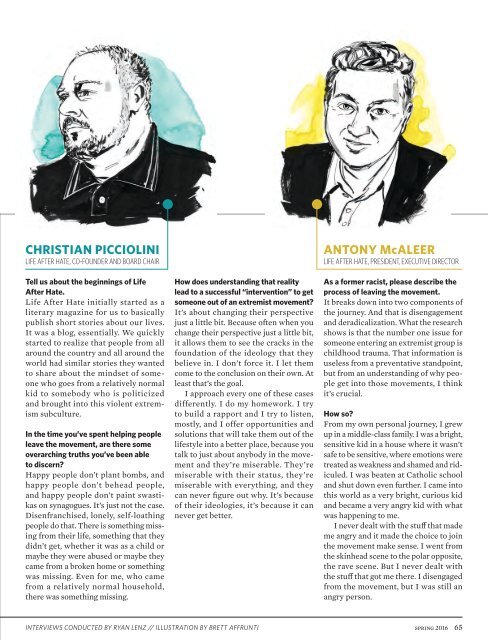Create successful ePaper yourself
Turn your PDF publications into a flip-book with our unique Google optimized e-Paper software.
CHRISTIAN PICCIOL<strong>IN</strong>I<br />
LIFE AFTER HATE, CO-FOUNDER AND BOARD CHAIR<br />
Tell us about the beginnings of Life<br />
After Hate.<br />
Life After Hate initially started as a<br />
literary magazine for us to basically<br />
publish short stories about our lives.<br />
It was a blog, essentially. We quickly<br />
started to realize that people from all<br />
around the country and all around the<br />
world had similar stories they wanted<br />
to share about the mindset of someone<br />
who goes from a relatively normal<br />
kid to somebody who is politicized<br />
and brought into this violent extremism<br />
subculture.<br />
In the time you’ve spent helping people<br />
leave the movement, are there some<br />
overarching truths you’ve been able<br />
to discern?<br />
Happy people don’t plant bombs, and<br />
happy people don’t behead people,<br />
and happy people don’t paint swastikas<br />
on synagogues. It’s just not the case.<br />
Disenfranchised, lonely, self-loathing<br />
people do that. There is something missing<br />
from their life, something that they<br />
didn’t get, whether it was as a child or<br />
maybe they were abused or maybe they<br />
came from a broken home or something<br />
was missing. Even for me, who came<br />
from a relatively normal household,<br />
there was something missing.<br />
How does understanding that reality<br />
lead to a successful “intervention” to get<br />
someone out of an extremist movement?<br />
It’s about changing their perspective<br />
just a little bit. Because often when you<br />
change their perspective just a little bit,<br />
it allows them to see the cracks in the<br />
foundation of the ideology that they<br />
believe in. I don’t force it. I let them<br />
come to the conclusion on their own. At<br />
least that’s the goal.<br />
I approach every one of these cases<br />
differently. I do my homework. I try<br />
to build a rapport and I try to listen,<br />
mostly, and I offer opportunities and<br />
solutions that will take them out of the<br />
lifestyle into a better place, because you<br />
talk to just about anybody in the movement<br />
and they’re miserable. They’re<br />
miserable with their status, they’re<br />
miserable with everything, and they<br />
can never figure out why. It’s because<br />
of their ideologies, it’s because it can<br />
never get better.<br />
ANTONY McALEER<br />
LIFE AFTER HATE, PRESIDENT, EXECUTIVE DIRECTOR<br />
As a former racist, please describe the<br />
process of leaving the movement.<br />
It breaks down into two components of<br />
the journey. And that is disengagement<br />
and deradicalization. What the research<br />
shows is that the number one issue for<br />
someone entering an extremist group is<br />
childhood trauma. That information is<br />
useless from a preventative standpoint,<br />
but from an understanding of why people<br />
get into those movements, I think<br />
it’s crucial.<br />
How so?<br />
From my own personal journey, I grew<br />
up in a middle-class family. I was a bright,<br />
sensitive kid in a house where it wasn’t<br />
safe to be sensitive, where emotions were<br />
treated as weakness and shamed and ridiculed.<br />
I was beaten at Catholic school<br />
and shut down even further. I came into<br />
this world as a very bright, curious kid<br />
and became a very angry kid with what<br />
was happening to me.<br />
I never dealt with the stuff that made<br />
me angry and it made the choice to join<br />
the movement make sense. I went from<br />
the skinhead scene to the polar opposite,<br />
the rave scene. But I never dealt with<br />
the stuff that got me there. I disengaged<br />
from the movement, but I was still an<br />
angry person.<br />
<strong>IN</strong>TERVIEWS CONDUCTED BY RYAN LENZ // ILLUSTRATION BY BRETT AFFRUNTI<br />
spring 2016 65


